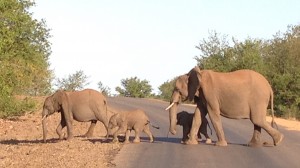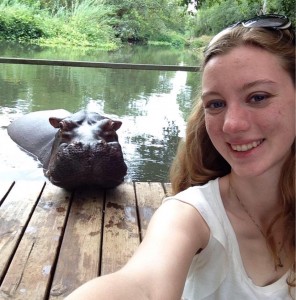For my STEP signature project, I went on a three week study abroad course to South Africa. The course’s focus was exotic animal welfare and behavior and is offered through the CFAES. Throughout this program we visited many animal facilities such as Kruger Park, sanctuaries, and farms. We also met many professionals working in various branches of the exotic animal field.
Before this trip I knew very little about South Africa’s culture so my original assumptions of how this project would benefit me were a bit vague. I knew that this program would give me a better understanding of exotic wildlife and how it affected daily life. However this experience gave me so much more than I could have imagined. The Exotic Animal Welfare and Behavior trip to South Africa has opened up my mind from a global perspective. I now see the importance of knowing how other cultures and countries function. South Africa in particular is impacted greatly by the native wildlife. A significant portion of the population is involved with animals in some way, such as game farming, the national parks, wildlife rehabilitation centers, animal sanctuaries, and agriculture. Witnessing South Africa’s native species and their natural behaviors firsthand was truly amazing and something that will stay with me forever. Since I stayed in South Africa for three weeks, it allowed me to immerse myself in the culture and see things from a new perspective. This trip has re-sparked my interest in exotic animals and has inspired me to be more proactive with global conservation issues.
The exotic animal behaviors witnessed throughout South Africa were truly amazing and gave a huge insight to how these animals fit within the food chain and society. In most zoos, animals that naturally live in large ranges or fields are confined to smaller spaces and thus are not as active as they would be in the wild. Because of this, many natural behaviors are not present within a zoo setting. Within Kruger Park, we witnessed numerous exotic animal behaviors that we most likely have never seen before. We saw large herds of elephants playing in water holes, fighting with each other, and traveling far distances that would never be possible within a captive setting. Some of the coolest behaviors we witnessed involved different species interacting with each other. For example, we stumbled upon a small pack of hyenas feasting on a recent kill along with some vultures and even a jackal. Seeing the predator vs prey relationship in the wild was extremely insightful to the overall food chain in Africa. All of the impala and antelopes were always on edge and constantly looking for predators, while the African cats spent their days lounging about in the sun. These examples of natural exotic behaviors and relationships are ones that could never really be seen in a captive setting and were truly amazing to experience
Outside of Kruger Park we didn’t see the same types of exotic behavior, but we did obtain more knowledge on certain animals’ physiology, health, and public’s opinion. At the Elephant Sanctuary we had a very informative lecture on the anatomy of an elephant. I was shocked to see how thick and wire-like the hairs on an elephant’s tail was and was surprised to hear that people pluck them to make jewelry. We also got to feel the cushions in an elephant’s heel which allows them to move softer and more quietly. We saw this firsthand in Kruger when herds of elephants moved practically silent. At the Moholoholo Rehabilitation center, our guide Oscar showed us a short presentation of habitat loss within South Africa. I was shocked to see how little land was devoted to the animals within national parks and how this is usually the only place they can live. It is especially problematic with predatory animals whom claim their territories and do not welcome other members of their species lightly, such as leopards and marshal eagles. Most of the animals we saw within the facility were captive bred and could not be released into the wild. Oscar informed us that most injuries they receive are from animals who get caught in snares or poaching traps. The snares were often set up by farmers whose livestock were being attacked from predators such as leopards. This shocked me since I see leopards are gorgeous amazing creatures while many South Africans viewed them as pests. Another animal that the public had negative views on was the hippo. I was unaware of this until we visited Jessica Hippo. Andy brought to our attention that hippos are seen as violent and annoying and are often shot if seen near people. Since hippos kill more people than any other animal in South Africa I can understand why society is not fond of them. Being close to Jessica was definitely intimidating, especially when she opened up her mouth. She was an amazing animal, but I was concerned about her health especially her nutrition and sugar content. I also did not think it was a good idea that they rescued another baby hippo, especially a male. Other than that though it was cool to interact with such a magnificent species and Jessica is a great hippo to help bring more positive views to her species.
In my opinion, the most important activity we did in South Africa was visit John Hume’s rhino farm. Before this trip I did not know much about rhino poaching or anything about dehorning. I knew that poaching was evil and dehorning did not sound very pleasant, but didn’t have the details. However after visiting Hume’s land, my opinion has drastically changed. The value of rhino horns astonishes me along with how violent and desperate the poachers are when obtaining them. While we were on Hume’s farm we heard gunshots in the distance and felt complete terror from the potential poacher threat. That moment really stuck with me. I now realize how important the current poaching issue is. The fact that in 15 years rhinos will become extinct worries me extremely. Not only do the poachers endanger rhinos, but also the people of South Africa. The poachers also target and murder anti-poaching workers and their families. This makes the issue far more significant to South Africa and the world than most people think. From a personal level this poaching problem really caught me off guard. The people of South Africa were extremely concerned while back in the US I never really heard about it. This has caused me to be extremely more open to hearing and seeking out current global issues.
As a pre-veterinary student I am always constantly thinking about what I want my future to be like. There are many types of animal fields out there, but exotics has always been something of my interest. However since the beginning of my college career I drifted away from the idea of working with exotic animals, feeling discouraged about the competiveness and difficulty of the field. This program has reinstated my initial desire to work with rare species and has opened my mind up to even more possibilities for my future. My newfound knowledge in exotic animal behavior and welfare will greatly benefit me in my future career.
Even if I am not able to work in the exotic field, this project has shaped me in ways that will benefit me in the veterinary/animal world and in my professional life. I am now open to more ideas and views, globally and locally. I have noticed my interest and curiosity in current issues to have grown, especially in the animal fields. Being in South Africa felt like being in a completely different world. I witnessed unique characteristics not seen in other countries such as the exotic wildlife, South African culture, breathtaking natural wonders, and many more unforgettable experiences. This trip was incredibly life changing to me and I thank STEP for supporting me throughout this extremely transformational time.


